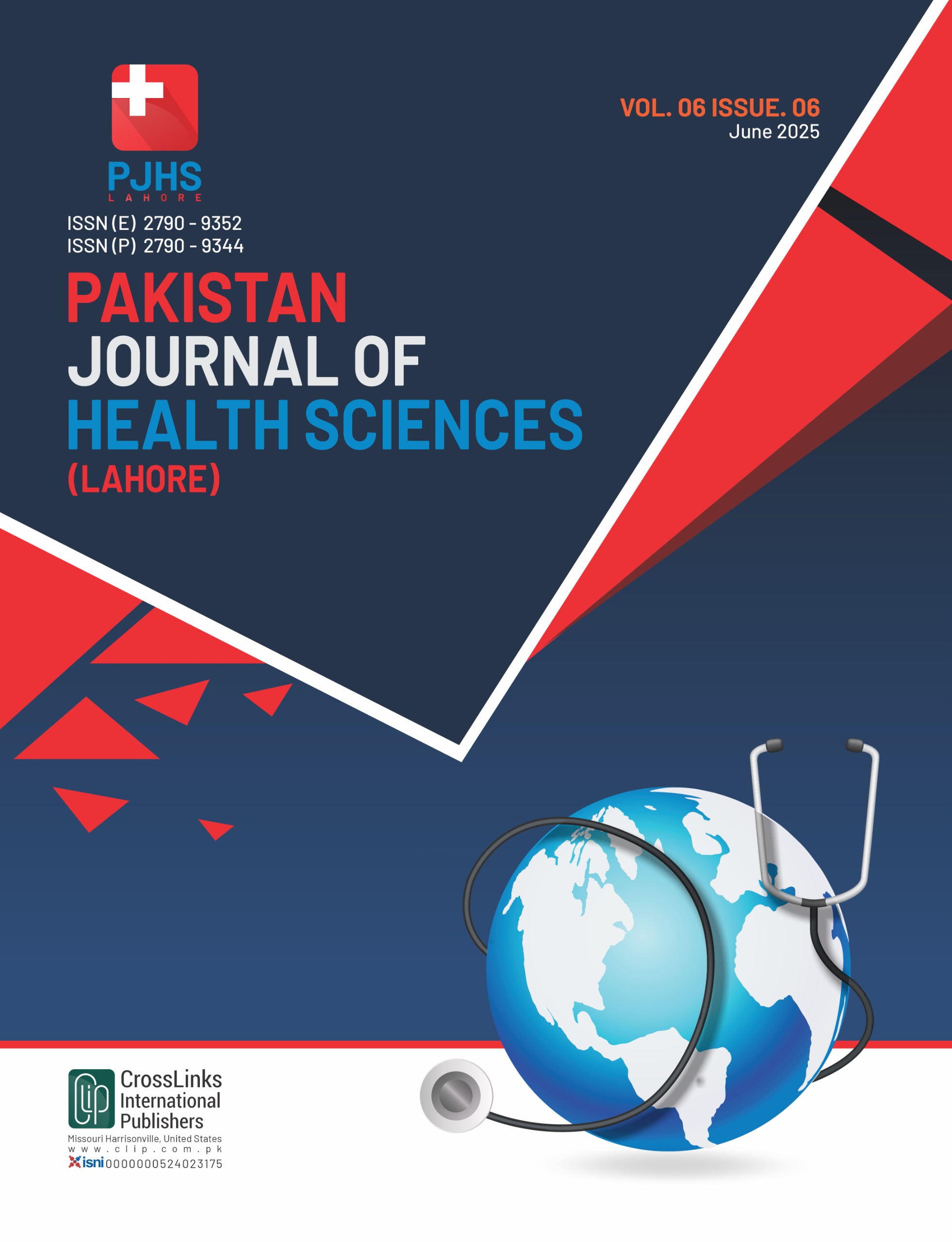Detection of Intrauterine Growth Retardation in 2nd And 3rd Trimester with Fetal Parameters and Umbilical Artery Doppler
Detection of Intrauterine Growth Retardation with Doppler
DOI:
https://doi.org/10.54393/pjhs.v6i6.3012Keywords:
Intrauterine Growth Restriction, Fetal Biometry, Umbilical Artery Doppler, Pulsatility IndexAbstract
Intrauterine Growth Restriction (IUGR) occurs when a fetus fails to reach its growth potential. Ultrasound plays a key role in diagnosis by assessing fetal biometry, and estimated weight. Umbilical artery Doppler studies evaluate placental function, with abnormal findings like increased resistance or absent/reversed end-diastolic flow. Objective: To detect Intrauterine growth retardation in 2nd and 3rd trimester with fetal parameters and umbilical artery doppler. Methods: This descriptive cross-sectional research took place at Diagnostic centre, Combined Military Hospital, Lahore from September to December 2024. All eligible 130 females in 2nd and 3rd trimester had recruited excluding females with Polyhydromnias. The examination involved the use of a curvilinear transducer (3-5MHz). Non probability convenient technique was employed for data collection. IBM (SPSS) version 26.0 was used for data analysis. For inferential statistics, Chi square test was employed. Statistical p-value <0.05 was considered as a significant value. Results: The study involved 130 pregnant women (mean age 28.82 ± 4.64), with 29.2% in the 2nd and 70.8% in the 3rd trimester. IUGR history (25.4%), gestational hypertension (50.8%), and diabetes (19.2%) were noted. IUGR was diagnosed in 52 cases with 3–6week growth delays. Abnormal PI values in all cases confirmed PI as a reliable marker. Conclusions: In conclusion, fetal biometric parameters (BPD, HC, AC, FL) below the 10th percentile indicated IUGR in over one-third of 2nd and 3rd trimester pregnancies, with growth lags of 15–43 days. Abnormal umbilical artery Doppler PI was present in all IUGR cases, highlighting PI as a consistent and reliable detection marker.
References
Abbas G, Shah S, Hanif M, Shah A, Rehman AU, Tahir S et al. The frequency of pulmonary hypertension in newborn with intrauterine growth restriction. Scientific Reports. 2020 May; 10(1): 8064. doi: 10.1038/s41598-020-65065-2.
Parijatha T, Rao PS, Bharathi PK. Role of doppler ultrasonography in prediction of adverse perinatal outcome in intrauterine growth retardation (IUGR). International Archives of Integrated Medicine. 2022 Feb; 9(2).
Yadav SS, Singh A, Yadav K. A prospective study to evaluate the role of routine early third trimester ultrasound in the diagnosis of intrauterine growth restriction and prediction of adverse perinatal outcome using color Doppler. International Journal Reproduction Contraception Obstetrics and Gynecology. 2020 Nov; 9(11): 4506-13. doi: 10.18203/2320-1770.ijrcog20204801.
Nnamani AO, Ibewuike CU, Okere PC, Obikili EN. Comparative analysis of umbilical artery doppler indices of normal and suspected IUGR fetuses in the third trimester. Nigerian Journal of Clinical Practice. 2021 Dec; 24(12): 1793-9. doi: 10.4103/njcp.njcp_46_18.
Shrivastava D and Master A. Fetal Growth Restriction. The Journal of Obstetrics and Gynecology of India. 2020 Apr; 70(2): 103-10. doi:10.1007/s13224-019-01278-4.
Aftab S, Ayaz S, Hussain SF, Hussain AS. Frequency and outcome of Intrauterine Growth Restriction (IUGR) in pregnancy induced hypertension. Pakistan Journal of Surgery. 2022 Jul; 38(3). doi: 10.54393/pjhs.v4i09.1019.
Khanduri S, Chhabra S, Yadav S, Sabharwal T, Chaudhary M, Usmani T et al. Role of color Doppler flowmetry in prediction of intrauterine growth retardation in high-risk pregnancy. Cureus. 2017 Nov; 9(11): e1827. doi: 10.7759/cureus.1827.
Murki S and Sharma D. Intrauterine growth retardation-a review article. Journal of Neonatal Biology. 2014; 3(3): 1-1. doi: 10.4172/2167-0897.1000135.
Albu AR, Anca AF, Horhoianu VV, Horhoianu IA. Predictive factors for intrauterine growth restriction. Journal of Medicine and Life. 2014 Jun; 7(2): 165.
El-Aal HM, Ellaban MM, Omran ME. Ultrasound Assessment of Fetal Transcerebellar Diameter to Abdominal Circumference Ratio (Tcd/Ac) and to Femur Length Ratio (Tcd/Fl) in Detection of IUGR. Al-Azhar International Medical Journal. 2023; 4(6): 13. doi: 10.58675/2682-339X.1851.
Samsury SF, Ismail TA, Hassan R. Low birth weight infant among teenage pregnancy in Terengganu, Malaysia: A cross-sectional study. Malaysian Family Physician: the Official Journal of the Academy of Family Physicians of Malaysia. 2022 Mar; 17(1): 44. doi: 10.51866/oa.59.
Naeem MA, Rauf H, Aftab SK, Mahrukh F, John A, Kiran W. Prevalence of Intrauterine Growth Retardation on Antenatal Ultrasound Scan in Lahore, Pakistan. Lahore Garrison University Journal of Life Sciences. 2022 Nov; 6(04): 350-9. doi: 10.54692/lgujls.2022.0604234.
Nanjundeswaraswamy TS and Divakar S. Determination of sample size and sampling methods in applied research. Proceedings on Engineering Sciences. 2021 Mar; 3(1): 25-32. doi: 10.24874/PES03.01.003.
Campos A KH and Murphy A. Umbilical arterial Doppler assessment Reference article, Radiopaedia.org 2024. 2025 Jan. doi: 10.53347/rID-13860.
Islam I, Yasmin T, Rubaiat L, Arephin SS, Hossain MM, Asfia A. Color Doppler Imaging of Cerebral-Umbilical Pulsatility Ratio in Intrauterine Growth Retardation. Journal of Enam Medical College. 2017 Oct; 7(3): 140-5. doi: 10.3329/jemc.v7i3.34073.
Shams F, Ali F, Samoo N, Malik F, Asif U, Gul A et al. To Associate the Fetal Distress, IUD and IUGR Observed in Normal, Diabetic and Hypertensive Pregnancies. Pakistan Biomedical Journal. 2022 Jan: 212-5. doi: 10.54393/pbmj.v5i1.256.
Li Y, Zhou S, Wang X, He Y, Shen L, Huang X et al. Study on the determinants of intrauterine growth restriction. Zhonghua liu Xing Bing xue za zhi= Zhonghua Liuxingbingxue Zazhi. 2015 Aug; 36(8): 807-10.
Mansour Ghanaei M, Amir Afzali S, Morady A, Mansour Ghanaie R, Asghari Ghalebin SM, Rafiei E et al. Intrauterine growth restriction with and without pre-eclampsia: pregnancy outcome and placental findings. Journal of Obstetrics, Gynecology and Cancer Research. 2022 Jan; 7(3): 177-85. doi: 10.30699/jogcr.7.3.177.
Kiran N, Aslam N, Tabassum T, Kanwal S, Zia T. Morphological findings in intrauterine growth restriction (IUGR) placentas versus normal placentas in pregnant women of district Rawalpindi, Pakistan. Gomal Journal of Medical Sciences. 2019 Sep; 17(3): 65-9. doi: 10.46903/gjms/17.03.2021.
Qahtani NA. Doppler ultrasound in the assessment of suspected intra-uterine growth restriction. Annals of African Medicine. 2011 Oct; 10(4): 266-71. doi: 10.4103/1596-3519.8704
Downloads
Published
How to Cite
Issue
Section
License
Copyright (c) 2025 Pakistan Journal of Health Sciences

This work is licensed under a Creative Commons Attribution 4.0 International License.
This is an open-access journal and all the published articles / items are distributed under the terms of the Creative Commons Attribution License, which permits unrestricted use, distribution, and reproduction in any medium, provided the original author and source are credited. For comments













